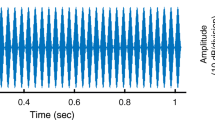Abstract
The present study attempted to determine the effect of practicing yoga on functioning of sacculo-collic pathway using cervical vestibular evoked myogenic potential (cVEMP). cVEMP was recorded from 40 participants (20 who practice yoga regularly and 20 who do not practice yoga regularly). The differences in amplitude of P1, N1, P1–N1 complex, asymmetry ratio and latencies of P1 and N1 of cVEMP were compared between both the groups. The results of the study showed that there was a significant increase (p < 0.05) in the amplitude of P1, N1 and P1–N1 complex and a significant reduction in latency (p < 0.05) for experimental group. The asymmetry ratio in individuals who practice yoga was significantly lower (Mean = 6.73) compared to the control group (Mean = 19.13). Multivariate regression analyses suggested that the number of years of yoga practice significantly predicted the amplitude of P1–N1 complex (β = 0.70, p < 0.01) and amplitude ratio (β = 0.72, p < 0.01). Thus, practicing yoga improves postural control and strengthens the muscles and vestibular system leading to enhanced cVEMP responses. The plastic changes in the vestibular system and increased muscular strength because of constant practicing of yoga could have led to changes in cVEMP responses. However, further studies on a larger group of individuals are essential for better clinical applicability of the results.


Similar content being viewed by others
References
DeAngelis GC, Angelaki DE (2012) Visual-vestibular integration for self-motion perception. In: Murray MM, Wallace MT (eds) The neural bases of multisensory processes. CRC Press/Taylor and Francis, Boca Raton (FL)
Bickford RG, Jacobson JL, Cody DT (1964) Nature of average evoked potentials to sound and other stimuli in man. Ann N Y Acad Sci 112:204–223
Welgampola MS, Colebatch JG (2001) Characteristics of tone burst-evoked myogenic potentials in the sternocleidomastoid muscles. Otol Neurotol 22(6):796–802
Sinha SK, Bohra V, Sanju HK (2013) Comparison of cervical and ocular vestibular evoked myogenic potentials in dancers and non-dancers. Audiol Res 3(1):e6
Tremblay K, Kraus N, Carrell TD, McGee T (1997) Central auditory system plasticity: generalization to novel stimuli following listening training. J Acoust Soc Am 102(6):3762–3773
Sharma A, Nash AA, Dorman M (2009) Cortical development, plasticity and re-organization in children with cochlear implants. J Commun Disord 42(4):272–279
Lavon H, Tal D, Kaminski-Graif G, Hershkovitz D, Shupak A (2010) Vestibular evoked myogenic potentials and saccular plasticity in divers. Aviat Space Environ Med 81(2):103–106
Gonshor A, Jones GM (1976) Extreme vestibulo-ocular adaptation induced by prolonged optical reversal of vision. J Physiol 256(2):381–414
Swathi VM, Sathish Kumar KS (2013) Influence of dance training on sacculo-collic pathway: vestibular evoked myogenic potentials (VEMP) as an objective tool. J Evol Med Dent Sci 2(40):7747–7754
Federici A, Bellagamba S, Rocchi MBL (2005) Does dance-based training improve balance in adult and young old subjects? A pilot randomized controlled trial. Aging Clin Exp Res 17(5):385–389
Krampe J, Rantz MJ, Dowell L, Schamp R, Skubic M, Abbott C (2010) Dance-based therapy in a program of all-inclusive care for the elderly. Nurs Adm Q 34(2):156–161
de Oliveira G, de Faria Oliveira JD, Rodrigues MR, Santaella DF (2016) Yoga training has positive effects on postural balance and its influence on activities of daily living in people with multiple sclerosis: a pilot study. Explor J Sci Heal 12(5):325–332
Ülger Ö, Yağlı NV (2011) Effects of yoga on balance and gait properties in women with musculoskeletal problems: a pilot study. Complement Ther Clin Pract 17(1):13–15
Carhart R, Jerger JF (1959) Preferred method for clinical determination of pure-tone thresholds. J Speech Hear Disord 24:330–345
Woodyard C (2011) Exploring the therapeutic effects of yoga and its ability to increase quality of life. Int J Yoga 4(2):49–54
Ciccone MM, Cortese F, Pinto M, Di Teo C, Fornarelli F, Gesualdo M et al (2012) Endothelial function and cardiovascular risk in patients with idiopathic sudden sensorineural hearing loss. Atherosclerosis 225(2):511–516
Prado ET, Raso V, Scharlach RC, Kasse CA (2014) Hatha yoga on body balance. Int J Yoga 7(2):133–137
Bhutkar MV, Bhutkar PM, Taware GB, Surdi AD (2011) How effective is sun salutation in improving muscle strength, general body endurance and body composition? Asian J Sports Med 2(4):259
Unkule N (2004) Advantages of suryanamaskars. Nisargopchar varta. Pune, India: National Institute of Naturopathy, pp 7–8
Author information
Authors and Affiliations
Corresponding author
Ethics declarations
Conflict of interest
The authors report no conflicts of interest. The authors alone are responsible for the content and writing of the paper.
Ethical considerations
In the present study, all the testing procedures done were using non-invasive technique adhering to conditions of ethical approval committee of the Institute and complied with the Declaration of Helsinki. All the test procedures were explained to participants before testing and informed consent has been taken from them for participating in the study.
Rights and permissions
About this article
Cite this article
Shambhu, T., Kumar, S.D. & Prabhu, P. Effect of practicing yoga on cervical vestibular evoked myogenic potential. Eur Arch Otorhinolaryngol 274, 3811–3815 (2017). https://doi.org/10.1007/s00405-017-4695-4
Received:
Accepted:
Published:
Issue Date:
DOI: https://doi.org/10.1007/s00405-017-4695-4




